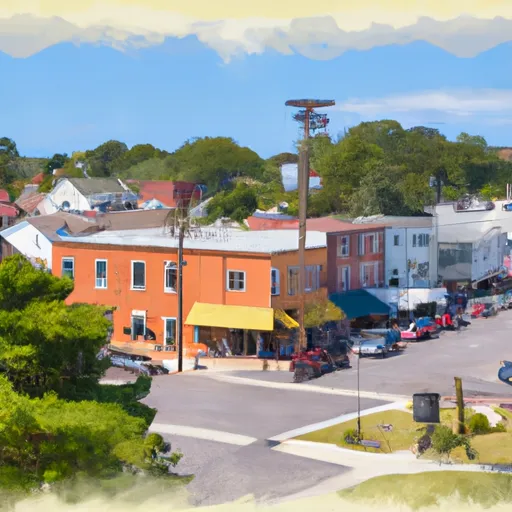-
 Snoflo Premium
Snoflo Premium
Get unlimited access to all our content
With no Ad interruptions! - Start Your Free Trial Login with existing account
Mexico
Eden Index
Climate
7.6
•
Recreation
2.4
•
Community
2.5
•
Safeguard
4.5/10

Mexico, Maine is a picturesque town located in Oxford County. Known for its stunning natural beauty, it offers a diverse climate and abundant outdoor recreation opportunities. The town experiences a continental climate with warm summers and cold winters. Average summer temperatures range from 70°F to 80°F, while winter temperatures can drop to 0°F or below, with heavy snowfall.
Hydrologically, Mexico is home to the Androscoggin River, which flows through the town and provides opportunities for fishing, swimming, and boating. The river also offers excellent kayaking and canoeing options, with scenic landscapes along its banks.
Outdoor enthusiasts will appreciate the area's numerous recreational opportunities. Hikers can explore nearby hiking trails, including the popular Bald Mountain Trail, offering breathtaking views of the surrounding countryside. The area is also dotted with lakes and ponds, perfect for fishing and swimming. In the winter, residents and visitors can enjoy activities such as skiing, snowboarding, and snowmobiling, as the region receives ample snowfall.
Overall, Mexico, Maine is a haven for outdoor enthusiasts, offering a varied climate, beautiful hydrological features, and an array of recreational activities throughout the year.
What is the Eden Index?
The Snoflo Eden Index serves as a comprehensive rating system for regions, evaluating their desirability through a holistic assessment of climate health, outdoor recreation opportunities, and natural disaster risk, acknowledging the profound impact of these factors on livability and well-being.
Climate Health Indicator (CHI): 7.6
Mexico receives approximately
1208mm of rain per year,
with humidity levels near 76%
and air temperatures averaging around
6°C.
Mexico has a plant hardyness factor of
5, meaning
plants and agriculture in this region thrive during a short period during spring and early summer. Most
plants will die off during the colder winter months.
By considering the ideal temperature range, reliable water supplies, clean air, and stable seasonal rain or snowpacks, the Climate Health Indicator (CHI) underscores the significance of a healthy climate as the foundation for quality living.
A healthy climate is paramount for ensuring a high quality of life and livability in a region, fostering both physical well-being and environmental harmony. This can be characterized by ideal temperatures, reliable access to water supplies, clean air, and consistent seasonal rain or snowpacks.
Weather Forecast
Streamflow Conditions
Androscoggin
Area Rivers
Androscoggin
Snowpack Depths
Androscoggin
Reservoir Storage Capacity
Androscoggin
Groundwater Levels
Recreational Opportunity Index (ROI): 2.4
The Recreational Opportunity Index (ROI) recognizes the value of outdoor recreational options, such as parks, hiking trails, camping sites, and fishing spots, while acknowledging that climate plays a pivotal role in ensuring the comfort and consistency of these experiences.
Access to outdoor recreational opportunities, encompassing activities such as parks, hiking, camping, and fishing, is crucial for overall well-being, and the climate plays a pivotal role in enabling and enhancing these experiences, ensuring that individuals can engage in nature-based activities comfortably and consistently.
Camping Areas
| Campground | Campsites | Reservations | Toilets | Showers | Elevation |
|---|---|---|---|---|---|
| Salmon Point City Campground | None | 280 ft | |||
| Rangeley Lake State Park | 50 | 1,590 ft | |||
| Mount Blue State Park | 135 | 718 ft |
Nearby Ski Areas
Catastrophe Safeguard Index (CSI):
The Catastrophe Safeguard Index (CSI) recognizes that natural disaster risk, encompassing floods, fires, hurricanes, and tornadoes, can drastically affect safety and the overall appeal of an area.
The level of natural disaster risk in a region significantly affects safety and the overall livability, with climate change amplifying these risks by potentially increasing the frequency and intensity of events like floods, fires, hurricanes, and tornadoes, thereby posing substantial challenges to community resilience and well-being.
Community Resilience Indicator (CRI): 2.5
The Community Resilience Indicator (CRI) recognizes that education, healthcare, and socioeconomics are crucial to the well-being of a region. The CRI acknowledges the profound impact of these elements on residents' overall quality of life. By evaluating educational resources, healthcare accessibility, and economic inclusivity, the index captures the essential aspects that contribute to a thriving community, fostering resident satisfaction, equity, and social cohesion.

